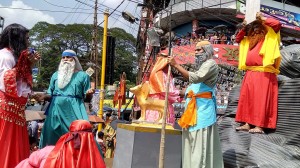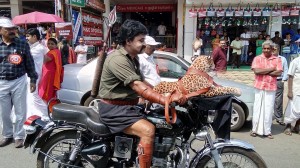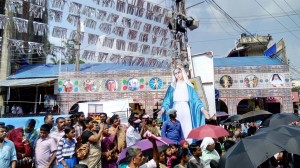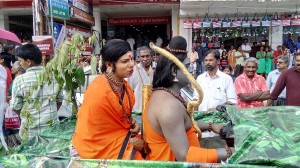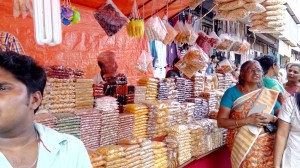Trading and religion have always gone hand in hand – the unpredictability of one unfailingly appealed to the vagary of the other. Pala, flanking the fertile banks of the Meenachil River, attracted farmer settlers from millennia ago. Recorded history shows they were mostly Christians or Nasrani – as the Syrian Christians of Kerala are known as – due to the evangelisation efforts of St Thomas who came ashore the sub-continent in the first century. Achayan, as the Nasrani menfolk are called, ably assisted by their chatta-clad wives toiled diligently, grew a lot of crops and children and made a lot of money. In time, they became comfortable enough in their everyday lives to focus on the afterlife. The church at Aruvithura some kilometres away was deemed too dangerous for the good folk of Pala – there were wild animals and dacoits en route. Pala needed its own church. The cornerstone of the first and the most imposing one to date, the Cathedral Church, was laid in 1002. This was followed by the two Lalam churches in 1611 and 1821. Accommodating an expanding flock was incidental – these churches were largely outcomes of gratuitous trade and bounding economic growth – which in turn led to the rise of big moneyed, egoistic and feuding families.
One wedding and a funeral
Prominent local Cherian Kurian’s dealings with the Armenians in port Kochi extended beyond profit-making business and into the scriptural realm. One of them gave Kurian the wherewithal to found a church dedicated to Mother Mary. It didn’t matter to either that a whole day stood between the Armenian and the Roman catholic churches commemorating the immaculate conception; Mary was the guiding star for seafarers whose safety was inextricably twined with local trader fortunes. The new church – Lalam Old – met with stiff resistance from worthies who were regulars at the Cathedral that stood just across the Meenachil. As differences intensified it took more than half a century to complete. Later, a tiff with Kurian’s descendants led to one faction moving away to set up their own Lalam, New, half a kilometre away. To seal the solemnisation, a baptism, a wedding and a funeral were all held the same day the foundation stone was laid. One of them, I am guessing, must have been a forced occasion. I just hope it wasn’t the last rite.
Churches continue to be built. And families, feud. But they are not the stuff of lore anymore. Religion is waning as a steadfast preoccupation as many settle abroad, the old wither and take refuge in ‘it’s all gone’ and the migrants are busy eking out a living. The frontispiece of Pala, Kurisupally (from ‘kurisu’ meaning ‘cross’ and ‘pally’ which is ‘church’), was set up in 1837 bang in the middle of town. But it was not until 1951 plans were drawn for the way it is today – seven storeys of sheer poetry in granite. And another quarter of a century for its construction. The spires visible from most parts of town, admittedly evocative of unbridled pride if you only cared enough to look at, the Kurisupally has become sort of iconic over the years. And this is despite several cooked efforts to make it more so – like the recorded rendition of the Big Ben chime that plays out through PA systems every quarter hour. I remember praying for the wires to short – a prayer that went on to be answered with frequent alacrity.
Kurisupally celebrated the first Jubilee Festival commemorating the immaculate conception of Jesus by Mary 112 years ago – when it was dedicated to the event on December 8, 1904. Probably due to its centric location or Spartan sacerdotal provisions or just an overwhelming urge of the factitious families to come together for once, the Jubilee was always celebrated with much aplomb. Bickering buried and dissension overlooked for this one occasion. The three churches historically put forth a unified face on Jubilee day. It became synonymous with Pala and soon enough her prestige. All the traders in town, in a remarkably pantheistic gesture, adopted it as their own. They not only contributed generously to its running and sponsorship coffers but also decked up their frontages with multi-hued lights and fresh coats of paint. It was bigger than Christmas.
The whole Lot
One heartening thing that struck me during this year’s edition was that the milling attendance was not borne out of condescension. The re-enacted Biblical scenes for the tableau competition were ones I had seen done to death when I used to attend every year without fail till about two decades ago. The faithful thronged with the same ardour as the curious immigrant or the passing itinerant. Then Lot’s wife always turned into salt and the idol over which Moses brought down his tablet was always of gold. The two-wheeler fancy dress competition though accords room for experimentation with participants exploring contemporary themes like blockbuster movies to social commentary. The religious fabric of Pala, harmonious till far, is also brought out by some in Hindu mythological avatars.
Celebrations begin early morning when batches of school students take to the main drag swishing ribbons and flags. I am not sure about this year but that’s how it used to be. Well, I don’t see why it shouldn’t be anymore – mobile telephony and internet couldn’t have annihilated that wonderfully amorous breed of eager swains. Jubilee used to be a sure-shot occasion to spend a few precious minutes with your love – you could always claim you bumped into each other. The tableau began as always with the sun peaking, the scorching heat cut rivulets through my sunscreened face and plastered my shirt to my back. However, the rest of me was comfy thanks to my mundu. I was a drape of excitement juddering about like the stalwart Communist VS Achuthanandan in the wake of a Congress scandal.
A lot of thought had gone into the floats and the fancy dress parade. For a prize booty of some thousands, participants had spent lakhs of rupees building their entries. Artisans and wood workers were employed for several weeks, veteran make-up artists were pressed into service. I asked Aladdin’s genie if he could help reopen the bars. I traipsed the length of the town – a little over a kilometre, anyway – thrice. It wasn’t any nostalgic walk down memory lane but the effort on display was impressive and the spectator himself was spectacle. Memory walks, if at all, happened that evening when I took my folks out for the traditional offering and pious welcoming of the ceremonial procession that was returning after a full day drumming its way through all the sub roads and bylanes of Pala. Mary was carried in a glass casket from house to house.
“Each member of every family was expected to put money in the alms box carried along with the procession,” my mom reminisced. “For those few moments from when you exited the house, walked down the steps and placed money in the box, you were the cynosure of all eyes. We kids used to get new clothes just for the occasion.” My mom had the additional advantage of having lived her childhood and youth years at the biggest house in town then – right next to the Kurisupally itself. The crowd used to be the max at this starting point of the processional journey. I looked around and some seemed to be sporting new dresses alright – fashionable hosiery tops and pappad-pleated saris. Not one was in a long skirt and blouse, what my mom wore, which remains my favourite.
Even in my own younger days we were all soigne and Sapeurs: we brushed our hair, wore shoes and trousers, shirts tucked in. Sartorial sensibilities befitted the occasion. Today mushroom coiffeur, tee shirts with a clever line or a solitary meep, low, low waist jeans and casual sandals templated fashion epitomes. No one seemed to look or care. I scouted searing eyes for a familiar pair. Earlier it was a rarity spotting a totally strange face, everyone being a passing acquaintance. Today there seemed to be none; most of my coevals were abroad hitched to nurses. From amidst toppled columns and cairns, cloaked with smoke from a hidden flue, from the scene of a bolting Lot someone called out my name. I was taking the close shot of a victim of the wrath in a bloodied habit decapitated by a spear cleaving through the neck. It looked up at me and winked. All the trailing crimson across the face, I barely managed to discern an old friend. He motioned me to follow.
Later that noon after the tableau drew to an end, Appachan and I caught up recounting old days. A forever yacker and reliable handyman to anyone who could pay, he was my procurer of alcohol when I was in school. An affable guy, I liked him for a characteristic ennui which made us do a lot of crazy things.
“I don’t believe you lay still for three hours,” I told him.
“Well, that’s the only way to stay out of trouble on Jubilee day,” he replied.
Thank Mary for some unchanged things.
(Some church related information in the post are based on an article written by Fr Sebastian Kollamparampil, vicar of Cathedral Church, in the Jubilee Festival supplement of Malayala Manorama, December 8, 2016.)



